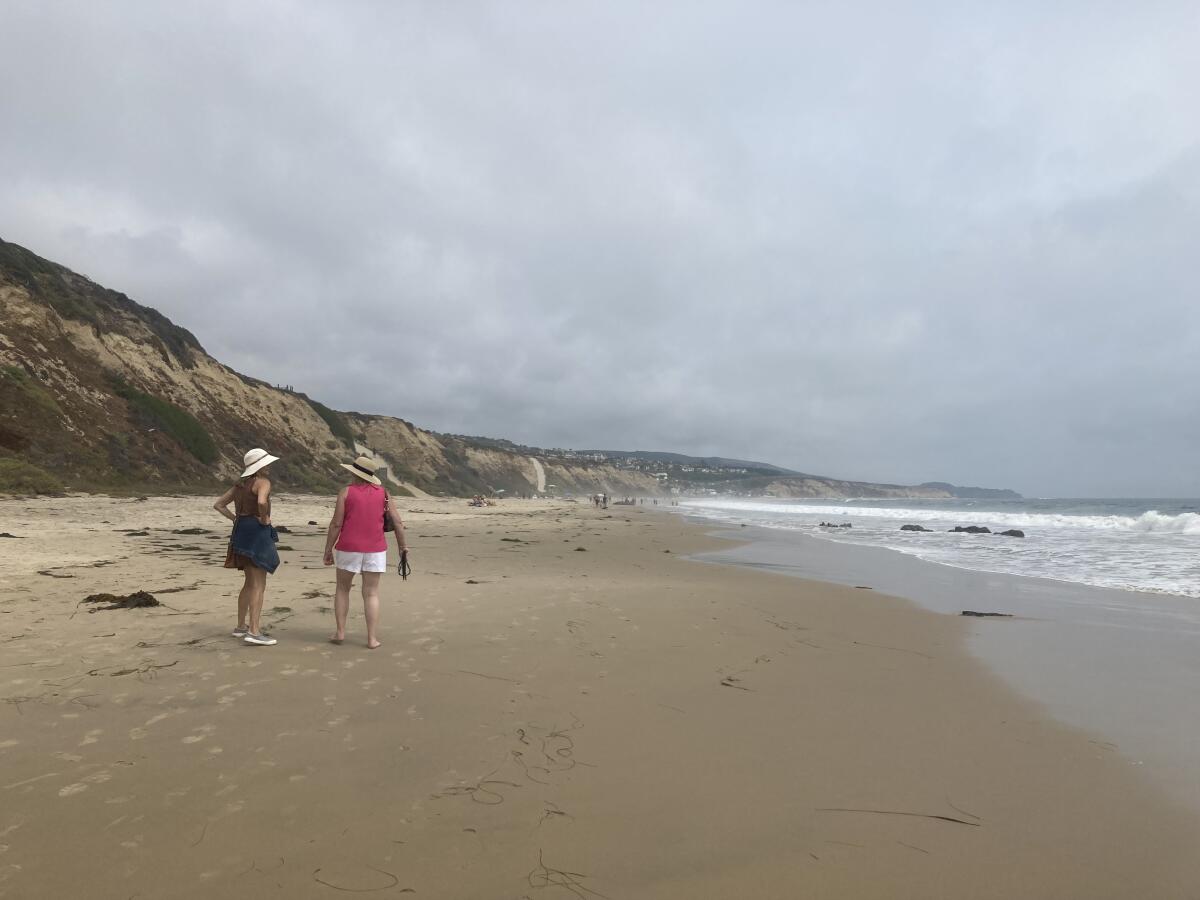How the Pac-12 became the Pac-2

Editors’ note: Get excited! A new and improved Essential California will land in your inbox tomorrow morning, bringing you more news, features and things to do in a sleeker, more digestible presentation.
Good morning, and welcome to the Essential California newsletter. It’s Wednesday, Sept. 6.
What was once known as the “Conference of Champions” is now all but dead at age 108.
USC football played its season opener against San Jose State on Aug. 26 — a 56 to 28 win that kicked off the season and the university’s farewell tour in the Pac-12 conference.
The Trojans aren’t the only ones departing the conference. UCLA, too, will leave for the Big Ten next season.
The announcements of their departure last summer created a domino effect as the conference that once defined college sports on the West Coast imploded: The University of Oregon and Washington both announced last month that they would also join the Big Ten. Arizona, Arizona State, Colorado and Utah are headed to the Big 12 while Stanford and Cal secured an invitation on Friday to the ACC (the Atlantic Coast Conference).
Here’s why it happened and why it matters to California’s schools, athletes and audiences.
More money, more exposure, better recruits
As my colleague Thuc Nhi Nguyen first reported when the USC and UCLA announcement dropped in June 2022, a chunk of this boils down to television deals.
The rights to broadcast or stream a sport are key to how schools and sports networks make money.
Studios such as ABC, NBC, CBS and Fox vie for the rights to exclusively broadcast games depending on the viewership potential of each conference. Which teams are playing? How do game times align with different time zones? (For the Pac-12, there was a historical disadvantage simply because of the three-hour difference. Games often started when people on the East Coast would go to bed.)
Schools like these deals because these rights, granted on a contractual basis to conferences, provide a more stable source of income compared to ticket sales and donations. The bigger the media rights deal, the bigger the payout for participating schools. More money means better facilities and the ability to recruit the best athletes. The Pac-12’s revenue fell behind those of its competitors, the SEC and Big Ten.
Broadcasting rights help explain not only why the conference fell apart, but why now — the Pac-12’s current media agreement expires in 2024, giving schools the chance to reevaluate their loyalties.
For student-athletes, a future of long flights and hotel stays
Coaches’ pitches to athletes just changed.
Different conferences offer students different opportunities for exposure and sponsorships. When changes to the Pac-12 first made the news, many high schoolers looking to win scholarships and compete at the college level were shocked.
There’s already been a shift in money flow for college athletes. In 2021, the NCAA lifted its ban on student-athletes inking their own sponsorship deals as a new era of name, image and likeness, or NIL, awareness began. Each state and school has its own set of rules, but Congress has recently proposed new federal legislation that would standardize NIL rules. Additional TV exposure across newer demographics could give some students a bigger profile in attracting sponsors.
Another consideration: Geography. A high schooler from L.A. might have welcomed a chance to play for UC Berkeley, knowing it would mean frequent trips home to play UCLA or USC. Not anymore. Those same players can expect to repeatedly fly across the country now instead. And charter flights aren’t cheap.
Flying from coast to coast to compete, will student-athletes get enough sleep and still attend their classes? Victoria Jackson, a sports historian at Arizona State University and former Pac-10 track and field athlete, suspects there will be less time in the classroom.
“The experiences of athletes are moving further and further from other students on campus,” Jackson said. “When you sign up to play in the now Big Four, the trade-off is a world class education. [For these student-athletes] their educational experiences are going to look very different moving forward.”
The “Olympic” sports
When it comes to football, schools will be willing to pay to send their teams where they’re needed. But less lucrative sports may suffer.
As the San Francisco Chronicle reported, the loss of a stable conference and the financial fallout could impact athletic programs that feed Olympic teams or other international competitions.
In 2020, Stanford announced a cut for field hockey, squash, women’s lightweight rowing, women’s fencing, coed synchronized swimming, coed sailing, men’s volleyball and wrestling. Saved by alumni donations and a lawsuit, many of these programs could be the first cut in efforts to save football scholarships.
Stanford has a rich history of sending its women’s soccer players to the World Cup and men’s gymnastics to the Olympics. At the 2021 Tokyo Olympics, Pac-12 athletes racked up 108 individual medals. Now with the conference changes, it remains to be seen where the nonfootball sports will land.
There is a concern for women’s athletics. Many collegiate softball players have spoken out against the Pac-12 realignment, citing the travel burden for their families. Most college athletic departments rely upon profits from football or men’s basketball to fund their other programs and debts. As the extra travel becomes too onerous financially and departments evaluate cuts, the inequality between men’s and women’s sports could grow.
“In most sports, the likelihood of going pro is very small. There are less professional opportunities for athletes in women’s sports simply because there are less professional teams and sports leagues,” Jackson added.
Each student-athlete must weigh opportunity costs.
“There’s a narrowing of imagining possible futures that happens with athletes, which is a tragedy,” Jackson said.
What does this mean for us as viewers and fans now?
Depending upon your proclivity for sports rivalries, there may be a period of mourning. Oregon State and Washington State are now in limbo and so are their traditional football rivalries.
Game watch times will change as teams travel east. The ACC is also considering adding “neutral” sites that are geographically central to accommodate conference members. (The closest competitor to Stanford and Cal will be 2,000 miles away in Louisville, Kentucky.)
Consider saving up some money for travel to see your favorite teams compete.
And now, here’s what’s happening across California from Laura Blasey:
Note: Some of the sites we link to may limit the number of stories you can access without subscribing.
L.A. STORIES
Running an Airbnb in L.A. has never been more profitable. As the city tries to crack down on illegal listings, and advocacy groups complain about the company’s effect on L.A.’s housing crisis, hosts are charging higher rates than ever while raking in bigger and bigger payouts. Los Angeles Times
Looking to avoid a parking ticket? We’ve got you covered. A Times analysis of parking ticket data in Los Angeles from Jan. 1 to July 31 pinpointed top spots where drivers get written up. Los Angeles Times
POLITICS AND GOVERNMENT
Mexico’s peso is soaring in value, but that’s not good news for everyone. Millions of Mexicans rely on remittances from the U.S. and the weakening dollar has upended finances and cross-border economic relationships. Los Angeles Times
On the surface, Dr. Pradyuman Singh has all the makings of the immigrant American dream — a job, a family, a Laguna Niguel home with ocean views. But his picturesque life in the U.S. has been unraveling almost since it started, underscoring the challenges families face in trying to legally navigate the U.S. immigration system. Los Angeles Times
A new UC Berkeley Institute of Governmental Studies poll co-sponsored by the Los Angeles Times finds that former President Trump has solidified a strong lead over his opponents in the race for the Republican nomination. He’s on track to win all of California’s delegates for next year’s Republican convention. Los Angeles Times
CRIME, COURTS AND POLICING
California is hoping a new system to prescribe treatment for those with serious mental illness will change the game. But with just weeks before CARE courts in select counties begin accepting cases, a complicated picture has emerged of families who feel the new law does too little to treat those with severe mental illness and civil libertarians who fear it will do too much. Los Angeles Times
Support our journalism
HEALTH AND THE ENVIRONMENT
From supplying incorrect instructions to filing bottles with the wrong medications, California pharmacies make an estimated 5 million errors every year, according to the state’s Board of Pharmacy. But big companies are fighting state efforts to increase transparency. Los Angeles Times
The Los Angeles County Department of Health employs 159 environmental health specialists tasked with protecting the public from foodborne illnesses. Like detectives looking for clues, they hunt for signs of unsanitary conditions: food debris, vermin droppings, rogue employee coffee cups. Here’s how they get the job done — and what earns a restaurant an A. Los Angeles Times
As climate change increases the strains on the Colorado River, a controversial proposal is receiving support from some surprising new allies: some California farmers are urging the federal government to consider draining Lake Powell, supporting environmentalists’ push for a “one-dam solution.” Los Angeles Times
CALIFORNIA CULTURE
These film school grads ditched studio jobs for YouTube and TikTok. How’s that going? It’s hard to say whether that new model of success is an improvement over traditional industry jobs, but the gamble is paying off for some. Los Angeles Times
A new Times series takes you inside a day on the job with some of the city’s most fascinating people. First up? Van Nuys-based astrologer and spiritual consultant Gogo Akopyan, who starts her morning with coffee, stirred clockwise, with intention. Los Angeles Times
Free online games
Get our free daily crossword puzzle, sudoku, word search and arcade games in our new game center at latimes.com/games.
AND FINALLY
Today’s California landmark is from Leslie Golson of Huntington Beach: Orange County’s Crystal Cove State Beach.

Leslie writes:
Crystal Cove is my favorite beach in Orange County, filled with local history, shorebirds, tide pools, and a wide sandy shore flanked by cliffs.
What are California’s essential landmarks? Fill out this form to send us your photos of a special spot in California — natural or human-made. Tell us why it’s interesting and what makes it a symbol of life in the Golden State. Please be sure to include only photos taken directly by you. Your submission could be featured in a future edition of the newsletter.
For the record: Yesterday’s newsletter incorrectly stated nearly a week had passed since Tropical Storm Hilary hit California. In fact, it has been more than two weeks.
Please let us know what we can do to make this newsletter more useful to you. Send comments to essentialcalifornia@latimes.com.
Sign up for Essential California
The most important California stories and recommendations in your inbox every morning.
You may occasionally receive promotional content from the Los Angeles Times.



